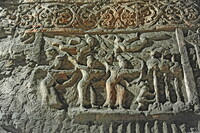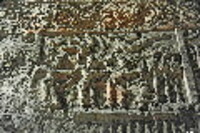| dc.coverage.spatial | Site: Yungang Grottoes (Datong, Shanxi, China) | en_US |
| dc.coverage.temporal | ca. 460-494 (creation); wooden facade 1621 (alteration) | en_US |
| dc.creator | unknown (Chinese) | en_US |
| dc.date | 460-494 | en_US |
| dc.date.accessioned | 2013-08-15T14:20:40Z | |
| dc.date.available | 2013-08-15T14:20:40Z | |
| dc.date.issued | 460-494 | en_US |
| dc.identifier | 229948 | en_US |
| dc.identifier.other | archrefid: 2360 | en_US |
| dc.identifier.uri | http://hdl.handle.net/1721.3/137732 | |
| dc.description | Cave 6 interior, carved horizontal bands with jātakas; The Yungang Grottoes are located 16 km west of Datong and comprise about 53 caves and 51,000 statues. The site stretches about 1 kilometer from east to west and was hollowed from the sandstone cliffs of the Wuzhou Mountains during the 5th century CE under the patronage of the Northern Wei dynasty. Founded by the Tuoba or Toba people, who ruled northern China during the Northern and Southern Dynasties period (310-589 CE), the Wei dynasty adopted Buddhism as its state religion. Work was begun at Yungang by the emperor Wenchengdi (reigned 452-465). The caves range in width from 23 m to a few metres. In 494, the Wei moved their capital from Datong to Luoyang and the Yungang Grottoes slowly fell into decay. The Grottoes have been a UNESCO World Heritage site since 2001. The sculptural style of the late 5th-century caves 5 and 6 conform more closely to Chinese taste and were among the last to be commissioned before the removal of the capital from Pingcheng (now Datong) to Luoyang in 494. Cave 6 has a large square central pillar carved in the shape of a wooden pagoda. Niches containing elaborately carved images of Buddha, bodhisattvas and apsarasas are organized in horizontal bands along the walls, and oblong reliefs in the lower register illustrate jātakas. During the early Qing Dynasty (ca. 1621), 4-storey wooden temple facades were built that still can be seen in front of the caves 5 and 6. Source: Grove Art Online; http://www.oxfordartonline.com/ (accessed 5/9/2011) | en_US |
| dc.format.medium | sandstone; polychrome (mineral pigment paint) | en_US |
| dc.rights | © Scott Gilchrist, Archivision, Inc. | en_US |
| dc.subject | architecture | en_US |
| dc.subject | decorative arts | en_US |
| dc.subject | deities | en_US |
| dc.subject | Buddhism and art--China | en_US |
| dc.subject | Silk Road | en_US |
| dc.subject | Buddhist cave art | en_US |
| dc.subject | Chinese | en_US |
| dc.subject | Northern Wei | en_US |
| dc.subject | Qing | en_US |
| dc.title | Yungang Grottoes: Cave 6 | en_US |
| dc.title.alternative | 云冈石窟 | en_US |
| dc.type | image | en_US |
| dc.rights.access | Licensed for educational and research use by the MIT community only | en_US |
| dc.identifier.vendorcode | 1A2-CH-D-YG-6-A105 | en_US |
| vra.culturalContext | Chinese | en_US |
| vra.technique | carving (processes), construction (assembling), painting and painting techniques | en_US |
| vra.worktype | shrine (structure) | en_US |
| vra.worktype | sculpture (visual work) | en_US |
| vra.worktype | relief (sculpture) | en_US |
| vra.worktype | façade | en_US |
| dc.contributor.display | unknown (Chinese) | en_US |



